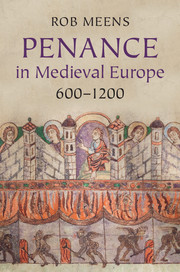Book contents
- Frontmatter
- Dedication
- Contents
- List of Figures
- Acknowledgments
- 1 Introduction
- 2 The late antique legacy
- 3 A new beginning? Penitential practice in the insular world
- 4 Insular texts on the move: penance in Francia and England
- 5 Penance and the Carolingian Reforms
- 6 New penitential territories: the tenth and eleventh centuries
- 7 The twelfth century
- Conclusion
- Appendix 1 The manuscripts of Theodore’s penitential
- Appendix 2 The manuscripts of the Excarpsus Cummeani
- Appendix 3 The manuscripts of the Bede and Egbert penitentials
- Appendix 4 The manuscripts of Halitgar’s penitential
- Sources
- Bibliography
- General index
- Manuscript index
- References
4 - Insular texts on the move: penance in Francia and England
Published online by Cambridge University Press: 05 August 2014
- Frontmatter
- Dedication
- Contents
- List of Figures
- Acknowledgments
- 1 Introduction
- 2 The late antique legacy
- 3 A new beginning? Penitential practice in the insular world
- 4 Insular texts on the move: penance in Francia and England
- 5 Penance and the Carolingian Reforms
- 6 New penitential territories: the tenth and eleventh centuries
- 7 The twelfth century
- Conclusion
- Appendix 1 The manuscripts of Theodore’s penitential
- Appendix 2 The manuscripts of the Excarpsus Cummeani
- Appendix 3 The manuscripts of the Bede and Egbert penitentials
- Appendix 4 The manuscripts of Halitgar’s penitential
- Sources
- Bibliography
- General index
- Manuscript index
- References
Summary
In the last chapter we saw that some Irish monasteries opened up ways for the laity to atone for their sins. This applied mostly to serious sins such as killing someone or having sex with someone you were not allowed to have such relations with. For people with close links to a monastery, such as the lay tenants or supporters of monastic institutions, more guidelines helping them to lead a Christian life would be offered. Such guidelines were codified in texts we call penitentials that were written in Ireland and adjacent territories in Britain. We have seen that Columbanus probably took a file of such texts with him when he travelled to Francia, where these were collected and with some other material fitting the local situation turned into a text later known as Columbanus’s penitential. In England Cummean’s penitential was known as a ‘libellus scottorum’. This shows that Irish monks following the urge to leave their home country took penitential texts with them. In Ireland the desire to leave your country for a peregrinatio, that is the ascetic practice of leaving your family and relatives to follow the way of Christ, was particularly strong. From the late seventh century onwards, English monks would follow in their wake. In travelling abroad Irish and Anglo-Saxon clerics seem to have taken penitential texts and attitudes with them, but had to adapt these to the new surrounding in which they found themselves. It is to the dissemination of insular penitential ideas and their adaptation to new circumstances that we shall now turn.
- Type
- Chapter
- Information
- Penance in Medieval Europe, 600–1200 , pp. 70 - 100Publisher: Cambridge University PressPrint publication year: 2014



